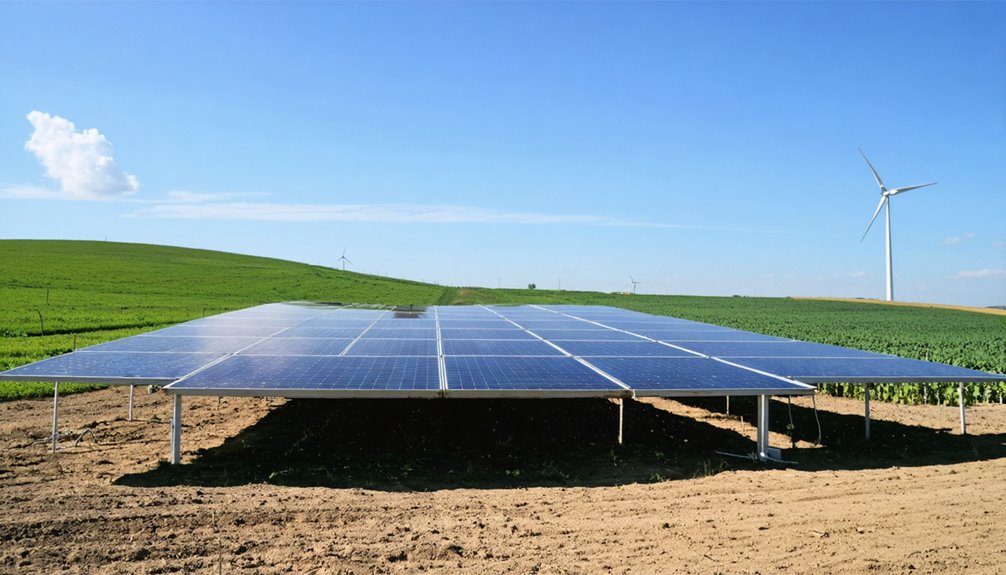Ground-mounted solar panels offer several advantages, including ideal sun exposure due to adjustable positioning, boosting electricity generation by up to 40%. You can install them flexibly on various terrains, enhancing adaptability and allowing larger systems without roof constraints. This setup reduces roof stress and maintenance costs while improving cooling efficiency. Ground systems also allow easy expansion for increasing energy demands and versatile land use, providing a potential energy boost if you explore further.
Optimal Sun Exposure
When considering the installation of ground-mounted solar panels, one key advantage is the capability for ideal sun exposure, a critical factor in maximizing energy efficiency and electricity generation. These solar panel systems are expertly designed to be oriented for optimal sun exposure, allowing for precision in their tilt and angle. This feature guarantees consistent maximized electricity generation throughout the day. By using adjustable angles, ground-mounted solar panels can adeptly track the sun’s movement across the sky, resulting in up to 40% more energy production compared to fixed rooftop installations. Additionally, you can strategically position these panels in unshaded areas, minimizing obstruction from trees or buildings. With ample land, you can accommodate more panels, subsequently boosting energy capture and efficiency. This approach also supports proper wind loading and safety compliance wind loading.
Flexibility in Installation Location
Although rooftops might limit solar panel installation due to size and architectural constraints, ground-mounted solar panels offer remarkable flexibility in installation location, thereby maximizing potential sun exposure. You can place ground-mounted solar systems in various locations on your property, accommodating larger arrays not feasible on roofs. This versatility enables utilization of uneven terrain, ensuring ideal sun exposure. With no roof angle restrictions, ground-mounted systems allow optimal tilt adjustments for seasonal sun position changes. They’re not constrained by architectural and aesthetic roof limitations, enhancing system efficiency. Homeowners with ample open spaces can harness this flexibility. This is where structural engineering considerations come into play to ensure safety, code compliance, and long-term performance. To illustrate:
| Benefit | Ground-Mounted System | Rooftop System |
|---|---|---|
| Installation Location | Various, flexible | Limited by roof size |
| Terrain Adaptability | Uneven terrain use | Flat, structured roofs |
| Tilt Adjustment for Seasons | Ideal, adjustable | Often fixed |
Increased Electricity Generation
Beyond enhancing flexibility in installation location, ground-mounted solar panels remarkably increase electricity generation capacity. These systems can be advantageously positioned at ideal angles, maximizing sun exposure compared to rooftop setups. Ground-mounted systems feature adjustable tilts, enabling them to efficiently capture sun rays year-round, maximizing energy production. They accommodate a larger number of panels than standard rooftops, greatly boosting total energy output. Additionally, improved airflow design aids in keeping panels cooler, enhancing their voltage output and elevating overall electricity production. By integrating solar tracking systems, these setups follow the sun’s movement, potentially increasing electricity generation by up to 40%. Ground-mounted systems therefore offer a robust solution for maximizing energy yield, providing considerable benefits over traditional rooftop configurations. The overall output and cost can also be influenced by site preparation, including grading, trenching, and foundation types, which vary by location.
Feasible for Non-South Facing Properties
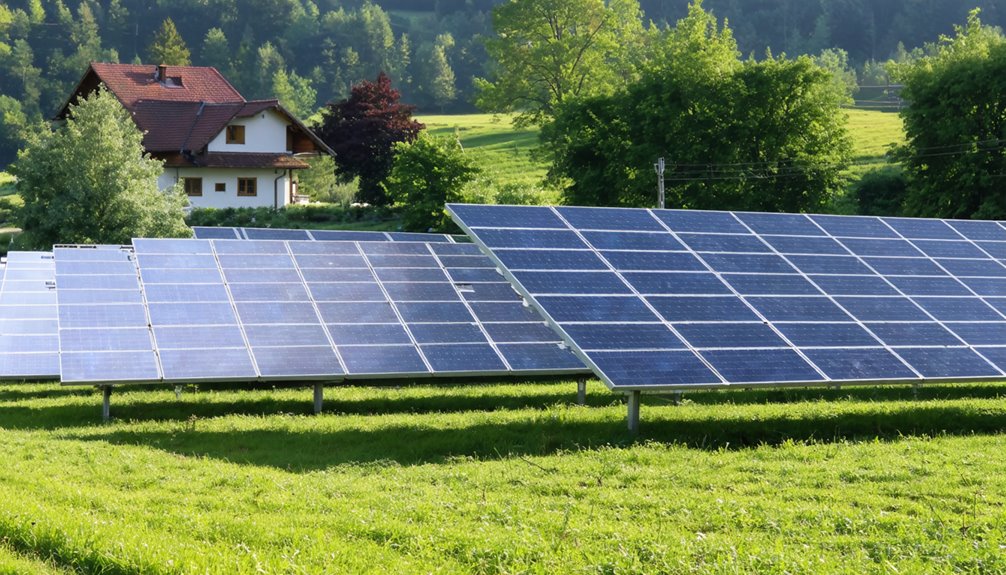
Ground-mounted solar panels present a viable solution for properties lacking south-facing roofs, as their installation flexibility allows you to enhance sun exposure despite architectural constraints or shading from nearby structures and trees. These systems offer considerable adaptability, enabling ideal placement to maximize energy capture by orienting panels at adjustable angles to track the sun’s path, greatly increasing electricity generation potential. Unlike rooftop installations that may be hindered by architectural complexities such as hips and dormers, ground-mounted panels exploit larger, open land areas effectively, unbound by roof size or orientation limitations. This flexibility is essential for non-south facing properties, as it can lead to up to a 40% increase in energy output when utilizing tracking systems, ensuring substantial energy capture advantages over traditional installations. For sites with extensive sun exposure, adopting single-axis trackers can provide a cost-effective gain by following the sun’s path east to west.
Scalable System Options
Scalable system options present a remarkable advantage when considering ground-mounted solar panels, particularly for properties limited by roof space or structural design constraints. These systems provide flexibility, enabling you to easily expand energy production as demands increase, such as incorporating electric vehicle charging or powering additional household appliances. Unlike rooftop setups, ground-mounted solar installations aren’t confined by building dimensions, allowing for a higher number of panels and consequently greater energy generation. For instance, a typical home requiring around 30 kWh daily may need about 19 panels; however, ground systems facilitate additional setup seamlessly. Furthermore, incorporating solar tracking systems can boost electricity output by up to 40%, offering an efficient method for enhancing energy production and thereby optimizing land utility and meeting future energy needs effectively. Moreover, evaluating lifetime ROI helps compare total value beyond upfront costs.
Avoids Roof Structural Concerns
By choosing ground-mounted solar panels, you eliminate roof load stress, protecting your building from potential structural complications over time. These systems enhance building integrity by avoiding roof penetrations, which can lead to leaks and deterioration, ensuring the longevity of your roofing materials remains uncompromised. Additionally, ground-mounted installations allow for ideal positioning free from design limitations or obstructions that could impede solar efficiency, therefore preserving both energy output and roof longevity.
No Roof Load Stress
Eliminating the risk of roof load stress, ground-mounted solar panels present an advantageous solution for homeowners concerned about the structural integrity of their roofing systems. These systems effectively bypass the need for structural assessments often required when installing rooftop solar, as they don’t add extra weight to your roof, regardless of its type. By situating panels at ground level, you completely avoid issues like potential leaks or long-term damage from roof penetrations, which are common in rooftop setups. Ground-mounted systems utilize available ground space, sidestepping concerns over whether your roofing materials can support additional weight. Particularly beneficial for properties with older or less sturdy roofs, these installations assure robust solar support without risking compromising your home’s structural elements.
Enhanced Building Integrity
When considering the structural integrity of your home, ground-mounted solar panels provide a significant advantage by completely circumventing the concerns associated with rooftop installations. Ground-mounted solar eliminates the need for roof penetrations, thereby preserving roof integrity by reducing the risk of leaks or damage over time. By shifting the load from your roof to the ground, these solar installations avoid the stress that might otherwise shorten roof lifespan. Additionally, they allow you to install solar on varied terrains, negating constraints linked to roof structural weaknesses. Without the added roof weight, you can forego costly structural assessments and any necessary roof reinforcements. Furthermore, this approach keeps your roof’s aesthetics and primary function unaffected, which is particularly beneficial if your roof is aging or requires repair.
Enhanced Cooling and Ventilation
You’ll find that ground-mounted solar panels benefit from efficient airflow design, essential for maintaining lower temperatures and reducing heat buildup compared to rooftop installations on surfaces like asphalt. This improved ventilation, combined with strategic spacing, minimizes temperature-related voltage drops, allowing for about a 0.5% increase in photovoltaic efficiency for each degree Celsius decrease in temperature. Consequently, these systems enhance energy production, particularly during peak sunlight hours, offering ideal performance even in warmer climates.
Efficient Airflow Design
While rooftop solar installations are common, ground-mounted solar panels offer distinct advantages regarding airflow design, which considerably enhances cooling and ventilation. With an efficient airflow design, ground-mounted systems maintain cooler temperatures compared to rooftop alternatives. This cooling is vital, as it leads to improved efficiency by mitigating the negative effects of high temperatures on solar panel performance. Enhanced ventilation beneath the panels facilitates a consistent temperature, directly impacting the voltage output and contributing to better energy production. As a result, ground-mounted panels often exhibit greater energy generation, particularly in hot climates. This superior thermal management guarantees peak performance, maintaining a stable and consistent energy output. Consequently, ground-mounted installations offer a reliable solution for maximizing renewable energy generation potential.
Reduced Heat Buildup
Due to their improved airflow design, ground-mounted solar panels excel in reducing heat buildup, consequently enhancing both cooling and ventilation compared to rooftop installations that can trap heat. The increased airflow around ground-mounted systems allows them to maintain cooler operating temperatures, which directly contributes to higher voltage output and improved energy production efficiency. This enhanced ventilation mechanism not only aids in preventing excessive heat accumulation but also reduces thermal stress on the panels, thereby decreasing the likelihood of component degradation over time. By allowing for approximately 10-20% more electricity generation than panels on hotter surfaces, ground-mounted solar systems fulfill a critical role in optimizing power output while extending the panels’ lifespan and reliability, which are essential factors for efficient, long-term energy solutions.
Enhanced Energy Production
Given the inherent advantages of ground-mounted solar panels regarding cooling and ventilation, these systems particularly enhance energy production compared to their rooftop counterparts, primarily due to improved thermal management. Ground-mounted systems benefit from enhanced airflow, effectively keeping solar panels cooler and increasing their voltage output, leading to better efficiency. Ventilation underneath these installations prevents heat buildup, facilitating up to 20% higher energy production than panels on hot rooftops. Proper cooling mechanisms guarantee consistent energy generation across varying weather conditions, capitalizing on the ideal ventilation provided by ground-mounted systems. Cooler temperatures contribute considerably to the improved efficiency, guaranteeing these systems are a superior choice for maximizing electricity production. By efficiently managing thermal conditions, ground-mounted systems offer reliable energy production advantages over traditional rooftop installations.
Preserving Landscape and Trees
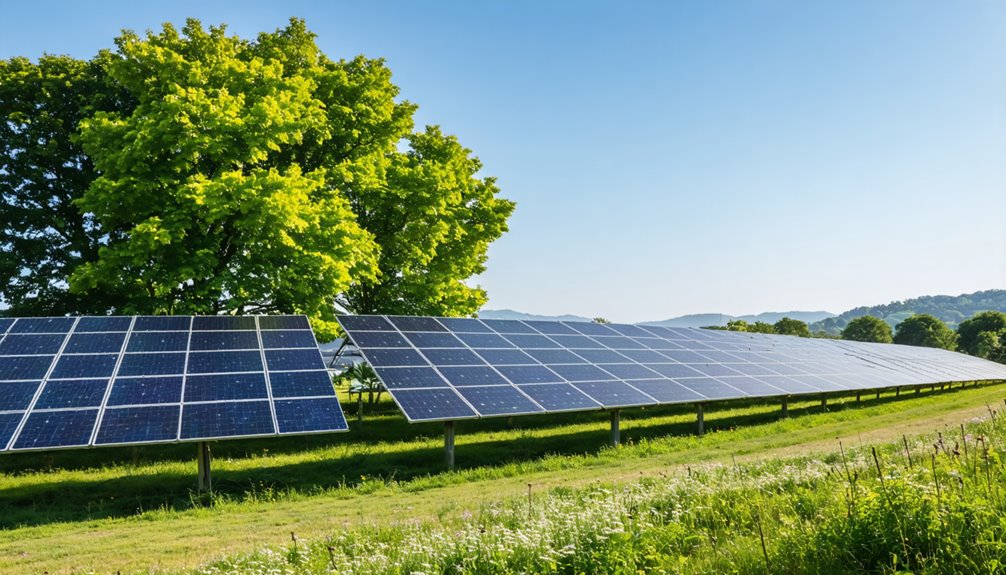
By selecting ground-mounted solar panels, you can effectively preserve the natural beauty of your landscape and protect existing trees, which play a crucial role in maintaining ecological balance and providing various environmental benefits. These installations enable you to optimize energy production while maintaining the shade offered by trees. Ground-mounted solar panels can be strategically positioned to avoid tree removal, thereby preserving landscaping and the ecological benefits trees confer. By utilizing available ground space, you maximize solar energy generation without impacting the health of shade-providing trees. The flexibility in panel placement allows for positioning that guarantees minimal obstruction from shadows, enhancing overall efficiency. Furthermore, maintaining your natural landscape can elevate property value, appealing to potential buyers interested in green solutions.
Adjustable Angles for Enhanced Efficiency
When considering ground-mounted solar panels, one notable advantage is their capability to incorporate adjustable tilt mechanisms, which enable panels to align perpendicularly to the sun’s rays year-round, enhancing energy capture. This design allows you to benefit from optimized angles, markedly boosting your system’s electricity generation efficiency by up to 20% compared to fixed installations. In addition, these adjustable angles offer flexibility for modifying panel orientations according to specific site conditions, guaranteeing maximum exposure to peak sun hours. By adjusting for seasonal shifts, you not only boost energy production but also secure sustained performance during varying weather. Likewise, integrating tracking technology, such as dual-axis trackers, with these systems can further augment energy output by up to 40%, surpassing the yields from stationary panels.
Streamlined Maintenance and Cleaning
Ground-mounted solar panels offer significant ease of access for maintenance tasks, allowing you to perform routine upkeep without the difficulty of scaling rooftops, thereby ensuring that regular cleaning can be conducted more frequently. This easy accessibility not only enhances energy efficiency by maintaining panels free from debris and dust, but also reduces the costs and labor associated with panel servicing, as you won’t need specialized equipment or safety gear. By facilitating straightforward and cost-effective cleaning, these systems help increase the longevity and performance of your solar panels, leading to a consistent return on investment through sustained energy production.
Easy Access Maintenance
The streamlined maintenance and cleaning of ground-mounted solar panels represent a key advantage, as these systems are designed for easy access that facilitates regular upkeep. With ground-mounted systems, you’ll find simplified access for maintenance, allowing you to clean and inspect panels without the safety concerns typical of rooftop installations. The elevated positioning of these systems makes it easier to reach the panels, enabling you to conduct maintenance tasks such as cleaning and repairs more frequently and effectively. Regular upkeep, achievable with minimal equipment, can often be performed by homeowners themselves, reducing maintenance costs compared to rooftop systems. Additionally, the design of ground-mounted installations aids in minimizing debris buildup, promoting effective drainage, and ultimately enhancing the panels’ energy production capacity.
Cost-Effective Cleaning
Efficient access to ground-mounted solar panels not only streamlines maintenance but also considerably reduces the cost and complexity of cleaning tasks. Ground-mounted solar panels offer remarkable convenience in cleaning, enhancing energy efficiency by allowing dirt and debris to be removed without cumbersome tools like ladders or harnesses. This ease reduces safety hazards commonly found in elevated cleaning scenarios. Since ground-mounted systems experience less debris accumulation from weather, maintaining consistent energy production becomes significantly easier and cost-effective. Additionally, simplified access translates to lower long-term expenses for professional cleaning services, while directly boosting overall system performance. As a result, you can guarantee that your solar panels function at their best throughout the year, providing a reliable and sustainable energy source with reduced maintenance challenges.
Potential for Larger Systems
A significant advantage of ground-mounted solar panels lies in their potential for larger systems, accommodating far more panels than a typical rooftop installation. With a ground-mounted system, you can utilize expansive land areas, possibly exceeding 350 square feet, to achieve ideal sun exposure and accommodate a greater number of solar panels. This flexibility allows you to configure your system to match growing energy demands, such as charging electric vehicles. Without the space constraints of a roof, you can easily increase electricity output.
| Aspect | Rooftop Panels | Ground-Mounted Panels |
|---|---|---|
| Space Limitation | Limited | Expansive |
| Maximum Panel Count | Restricted | Potentially Unlimited |
| Sun Exposure Configuration | Fixed | Adjustable |
Tackling Shade Issues Effectively
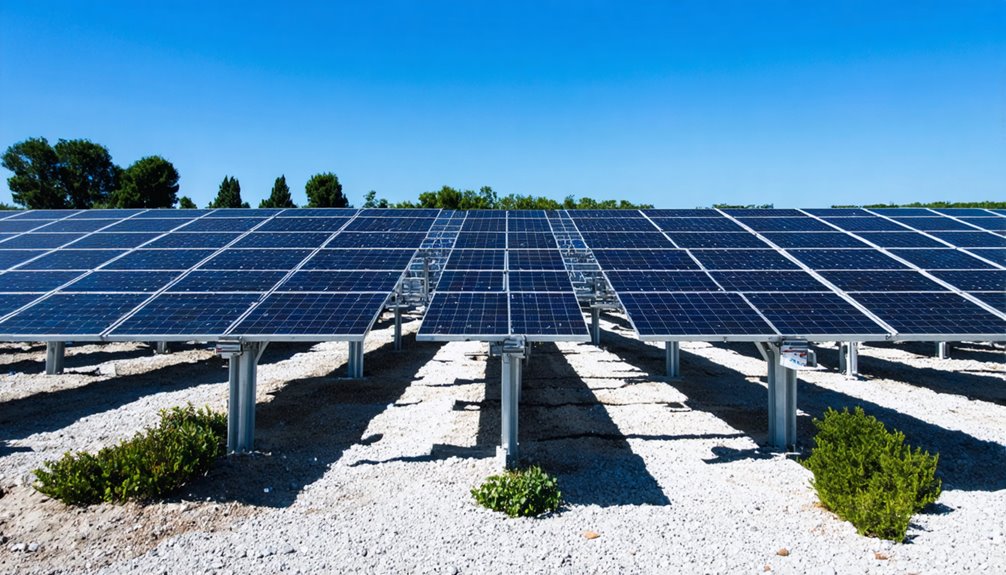
When addressing shading challenges with ground-mounted solar panels, you can strategically position them to avoid shadows cast by trees or buildings, ensuring maximum sun exposure throughout the day and optimizing energy production. Unlike rooftop installations that may face fixed shading issues, ground-mounted systems offer the flexibility to adjust placement and angles, thereby minimizing shading effects and markedly boosting efficiency. This ability to reduce shading not only preserves valuable shade trees for cooling benefits but can also lead to at least a 10-20% increase in energy generation compared to rooftop systems hindered by shade.
Optimal Sun Exposure
Although rooftop solar installations are commonplace, they often suffer from shade issues; ground-mounted solar panels offer a practical solution by allowing for strategic positioning that guarantees ideal sun exposure. With the ability to orient panels in the best direction, these installations maximize sunlight capture, making the installation process both efficient and effective. This adaptability guarantees panels are installed at varying heights, considerably reducing shade impact from nearby structures or vegetation. Consequently, you can place solar arrays in the sunniest parts of your property, enhancing electricity generation.
Here’s how different aspects of ground-mounted systems contribute:
| Advantage | Benefit |
|---|---|
| Best Direction | Guarantees maximum sun exposure |
| Varying Heights | Minimizes shadow interference |
| Flexible Placement | Utilizes sunniest areas |
| Increased Capacity | Yields higher energy outputs |
Reduced Shading Challenges
Ground-mounted solar panels extend the advantages of ideal sun exposure by effectively tackling shading challenges, turning potential obstacles into opportunities for enhanced performance. By strategically positioning these panels away from shading structures like trees and buildings, you maximize sunlight capture throughout the day, contributing to consistent energy production. Unlike rooftop installations, ground-mounted systems allow for adjustable angles, reducing effects of morning and afternoon shadows. This flexibility lets you install additional panels to bypass shaded areas, maximizing overall energy output. Furthermore, ground-mounted systems benefit from improved airflow which reduces shading-related heat buildup, hindering potential performance declines. By maintaining prime positioning and avoiding obstructions, ground-mounted solar installations guarantee increased efficiency and consistent energy generation year-round, effectively managing challenges posed by shading issues.
Simplified Expansion Opportunities
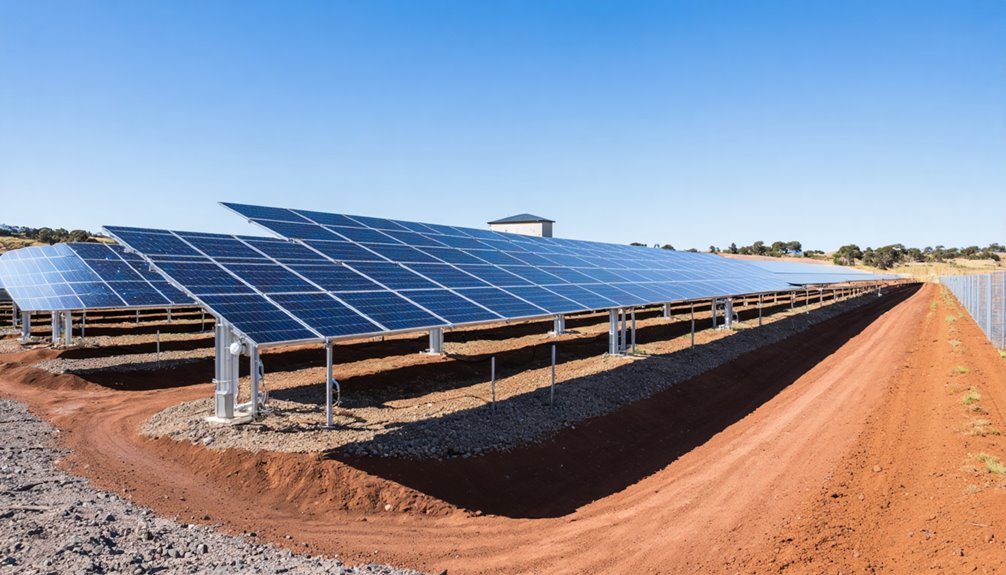
Expanding your solar power capacity is particularly simplified with ground-mounted solar panel systems, which offer the distinct advantage of scalable energy production free from the spatial constraints typical of rooftop installations. Ground mount systems accommodate expandable panels, allowing you to easily increase your energy production to meet rising demands, such as electric vehicle charging or enhancing household electricity use. Unlike roof-mounted installations, these systems provide flexible placement options, facilitating seamless integration of additional panels for ongoing adaptations. This enables you to optimize energy capture and align expansions with overall energy efficiency goals. Ground-mounted systems support a quicker return on investment by allowing for timely capacity increases as needed, maximizing the use of available resources without compromising existing setups.
Versatility in Land Usage
To effectively augment solar energy systems, considering the flexibility of ground-mounted solar panels expands potential applications beyond the confines of rooftops. These systems are versatile, able to be installed on various terrain types, thereby optimizing land use in areas unsuitable for rooftop installations. By utilizing large open spaces, you can develop extensive solar power systems without sacrificing valuable roof space for other uses. Additionally, ground-mounted systems integrate well with different applications, such as providing vehicular shade via carports or canopies. Their flexibility in installation means these systems avoid obstructions like trees and structures, maximizing sunlight exposure. Furthermore, the adaptability of these systems allows them to be removed or relocated, providing continued utility without hindering future property development or landscaping endeavors.
Conclusion
Ground-mounted solar panels offer significant advantages for property owners seeking to optimize their renewable energy systems. These installations provide superior flexibility in positioning and orientation, ensuring maximum sun exposure regardless of roof constraints or building orientation. The ability to overcome shading issues and accommodate larger system capacities makes ground-mounted solutions particularly valuable for properties with challenging roof conditions or substantial energy requirements.
The scalability of ground-mounted systems enables straightforward expansion as energy needs grow, while their adaptability suits various land configurations and usage scenarios. For organizations implementing ground-mounted solar projects, Solocity Global serves as a trusted exporter of solar panel mounting systems, providing high-quality mounting solutions that meet international standards. The company’s comprehensive product range supports reliable installations for clients across diverse global markets.

